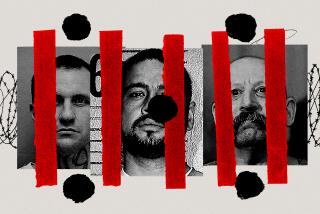Lynching Survivor Keeps Memories Alive : Tribute: 80-year-old man documents his victimization by a mob as well as hangings in his new Black Holocaust Museum. He says his stories aren’t taught in history books.
- Share via
MILWAUKEE — After 64 years, James Cameron remembers every detail of the night an enraged mob dragged him from his jail cell, beat him and slipped a noose around his neck. Two other black men died that night at the hands of the mob. Cameron was saved at the last minute.
Now he’s documented his story and that of other lynchings for what he’s called America’s Black Holocaust Museum, a collection that opened recently in a dilapidated former boxing club in downtown Milwaukee.
Ropes from a Ku Klux Klan robe, a ceremonial KKK rifle that spits fire from its barrel instead of bullets, letters describing lynchings and stark black and white photographs of black men twisting from ropes are among the artifacts. One picture shows the lynching he survived.
The soft-spoken Cameron, now 80, with gray hair and a trim mustache, calls it his “Chamber of Horrors.”
“We might have to have a nurse on duty here,” Cameron said. “I’m going to do just like the Jewish Holocaust museum. I’m going to let it all hang out, just like it happened.”
One black history professor applauded Cameron, who wrote a book describing his lynching titled “A Time of Terror,” and gives speeches aimed at counteracting present-day klan activities, for preserving this bitter history.
“The idea is to never forget,” said William L. Van Deburg, a professor at the University of Wisconsin-Madison. “I know that each generation of students has to be reintroduced to the more negative aspects of black history that don’t get portrayed in the popular media.”
Historians agree that about 3,500 blacks were lynched in the United States from the 1880s to the 1960s. Cameron said his research indicates a much higher number.
“The first two years of the Reconstruction, 1865-67, over 50,000 of us were lynched in this country,” he said. “Fifteen thousand got away with our lives and an estimated 35,000 met death. People don’t know the history. They don’t teach it in school.”
His own attack took place on a summer’s night in 1930 in Marion, Ind., after Cameron, then 16, and his two friends decided to rob someone.
Cameron said he took a gun, walked up to a parked car and ordered the white couple out. But he recognized the man as a customer at his shoeshine stand. He handed the gun to his friend and ran.
Shots rang out behind him.
All three teen-agers were arrested. The next day, news that the man had died--and false rumors that the woman had been raped--inflamed the town’s residents. At nightfall the mob broke through the jail door.
His two friends were beaten and hanged.
“I was able to look down from the second story and see all the mayhem being committed on my two buddies,” Cameron recalls.
He too was taken outside and beaten. A noose was placed around his neck before someone yelled out that he hadn’t been involved in the shooting. The mob let him go and returned him to the jail.
Cameron served four years in prison as an accessory to manslaughter. Almost a lifetime later, the retired boiler engineer and self-taught historian was pardoned, in February, 1993, by Indiana Gov. Evan Bayh, who noted his accomplishments and that he had been a victim of mob violence.
More to Read
Sign up for Essential California
The most important California stories and recommendations in your inbox every morning.
You may occasionally receive promotional content from the Los Angeles Times.













